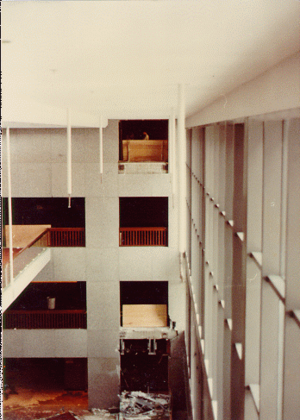Hyatt Regency walkway collapse

Locations of the second- and fourth-story walkways, which both collapsed into the lobby of the Hyatt Regency hotel.
|
|
| Time | 19:05 (CST) (UTC−6) |
|---|---|
| Date | 17 July 1981 |
| Location | Kansas City, Missouri, United States |
| Cause | Insufficient Load Capacity |
| Deaths | 114 |
| Non-fatal injuries | 216 |
The Hyatt Regency walkway collapse took place at the Hyatt Regency Kansas City hotel in Kansas City, Missouri, on July 17, 1981. Two vertically contiguous walkways collapsed onto a tea dance being held in the hotel's lobby. The falling walkways killed 114 and injured 216. At the time, it was the deadliest structural collapse in U.S. history, not surpassed until the collapse of the World Trade Center towers twenty years later.
The construction of the 40-story Hyatt Regency Kansas City began in May 1978. Despite delays and setbacks, including an incident on October 14, 1979 when 2,700 square feet (250 m2) of the atrium roof collapsed due to the failure of one of the connections at its northern end, the hotel officially opened on July 1, 1980.
One of the defining features of the hotel was its lobby, which incorporated a multistory atrium spanned by elevated walkways suspended from the ceiling. These steel, glass and concrete crossings connected the second, third and fourth floors between the north and south wings. The walkways were approximately 120 ft (37 m) long and weighed approximately 64,000 lb (29,000 kg). The fourth level walkway aligned directly above the second level walkway.
On the evening of July 17, 1981, approximately 1,600 people gathered in the atrium to participate in and watch a tea dance. At 7:05 p.m. the second-level walkway held approximately 40 people with more on the third and an additional 16 to 20 on the fourth level who watched the activities of the crowd in the lobby below. The fourth-floor bridge was suspended directly over the second-floor bridge, with the third-floor walkway offset several meters from the others. Construction difficulties resulted in a subtle but flawed design change that doubled the load on the connection between the fourth-floor walkway support beams and the tie rods carrying the weight of both walkways. This new design was barely adequate to support the dead load weight of the structure itself, much less the added weight of the spectators. The connection failed, and the fourth-floor walkway collapsed onto the second-floor walkway. Both walkways then fell to the lobby floor below, resulting in 111 deaths at the scene and 219 injuries. Three additional victims died after being transported to hospitals, bringing the total number of deaths to 114.
...
Wikipedia
